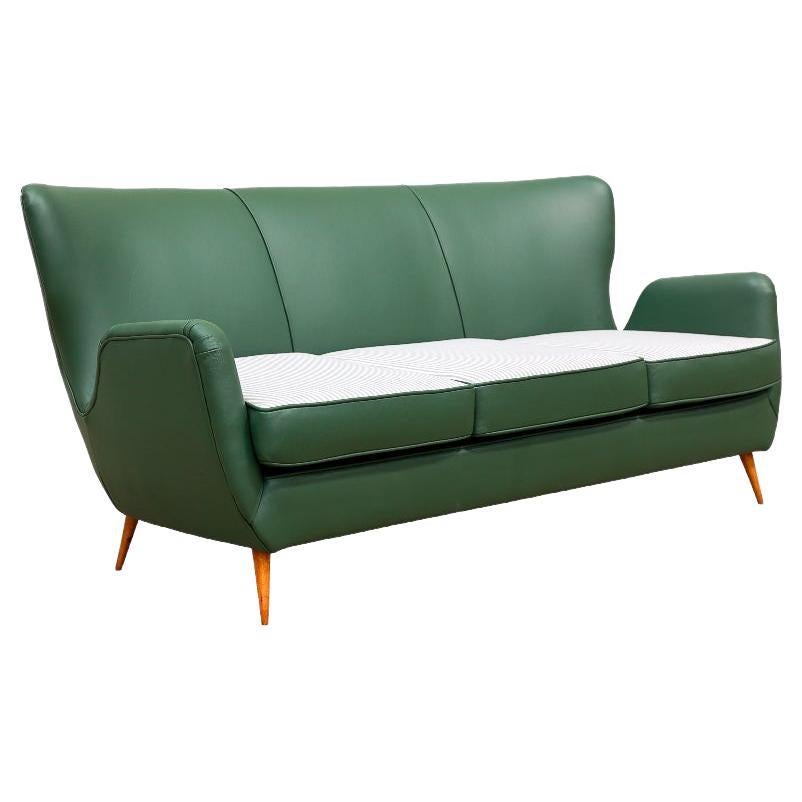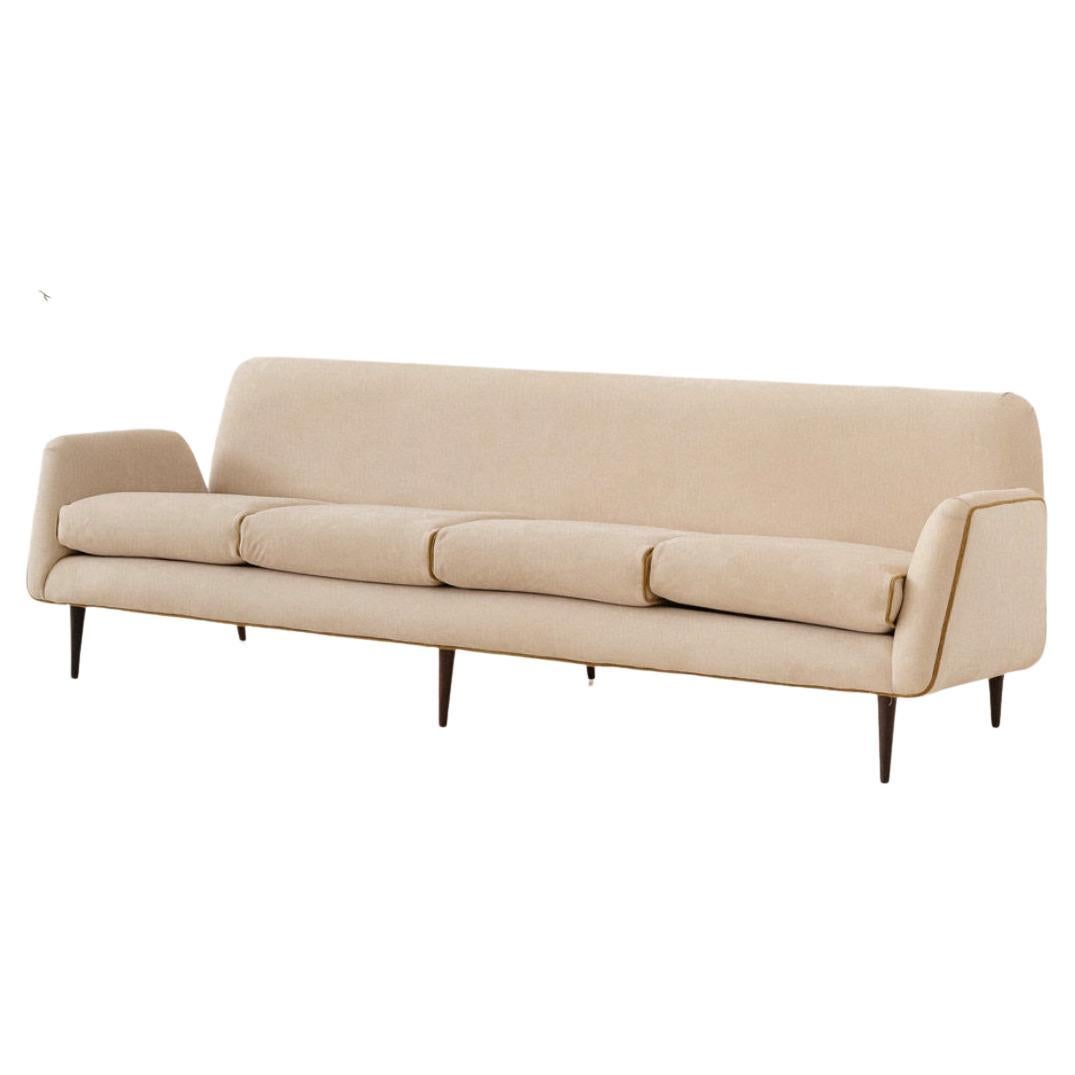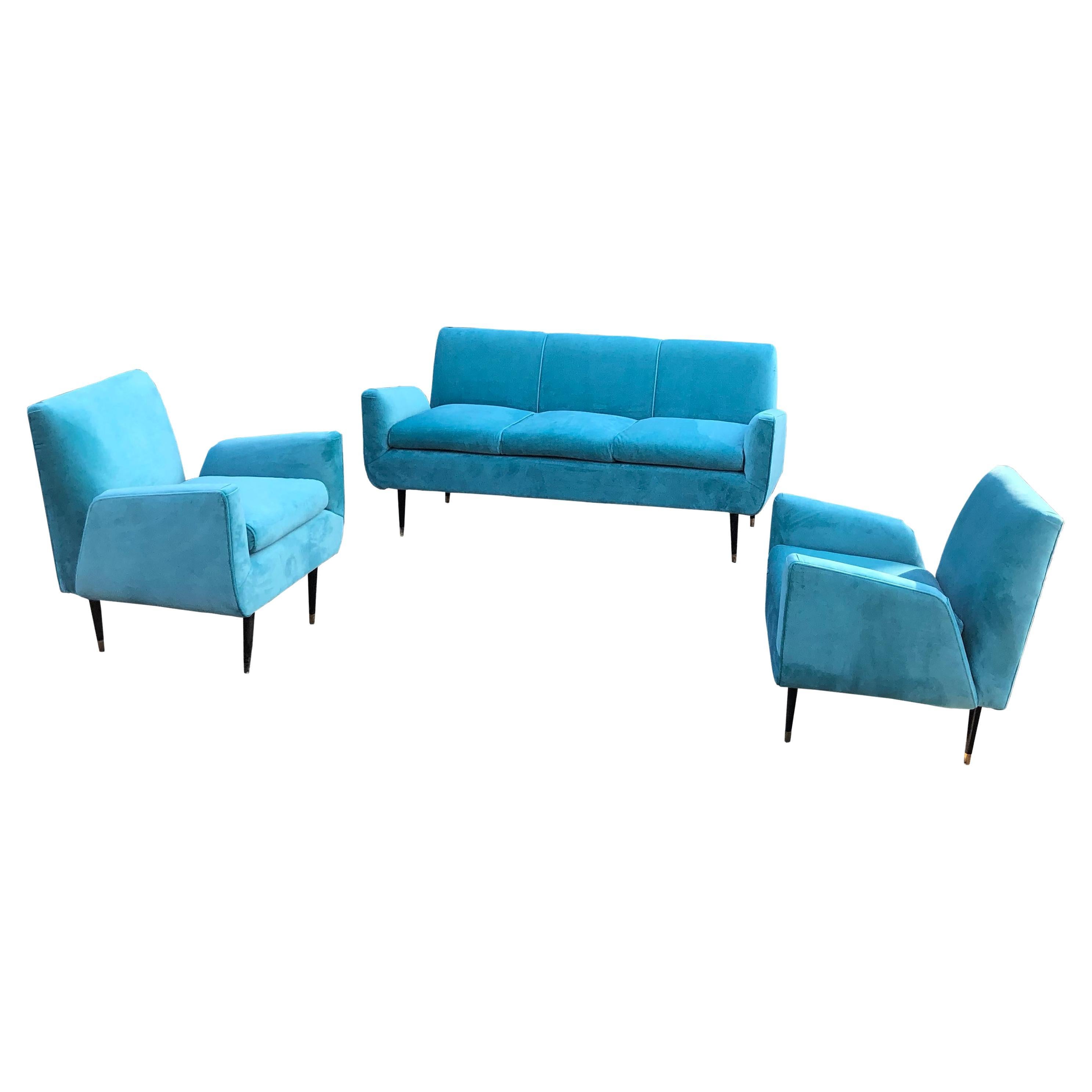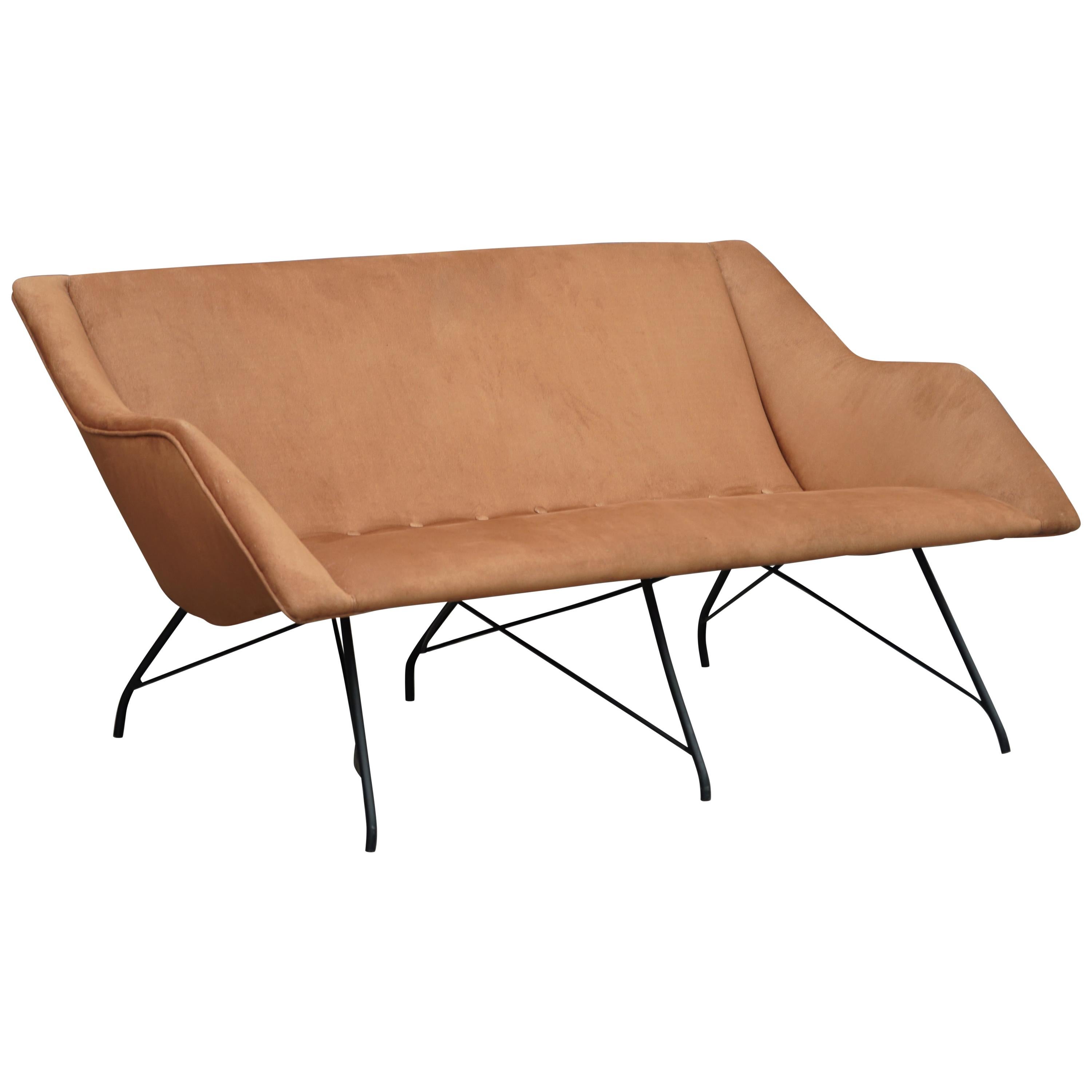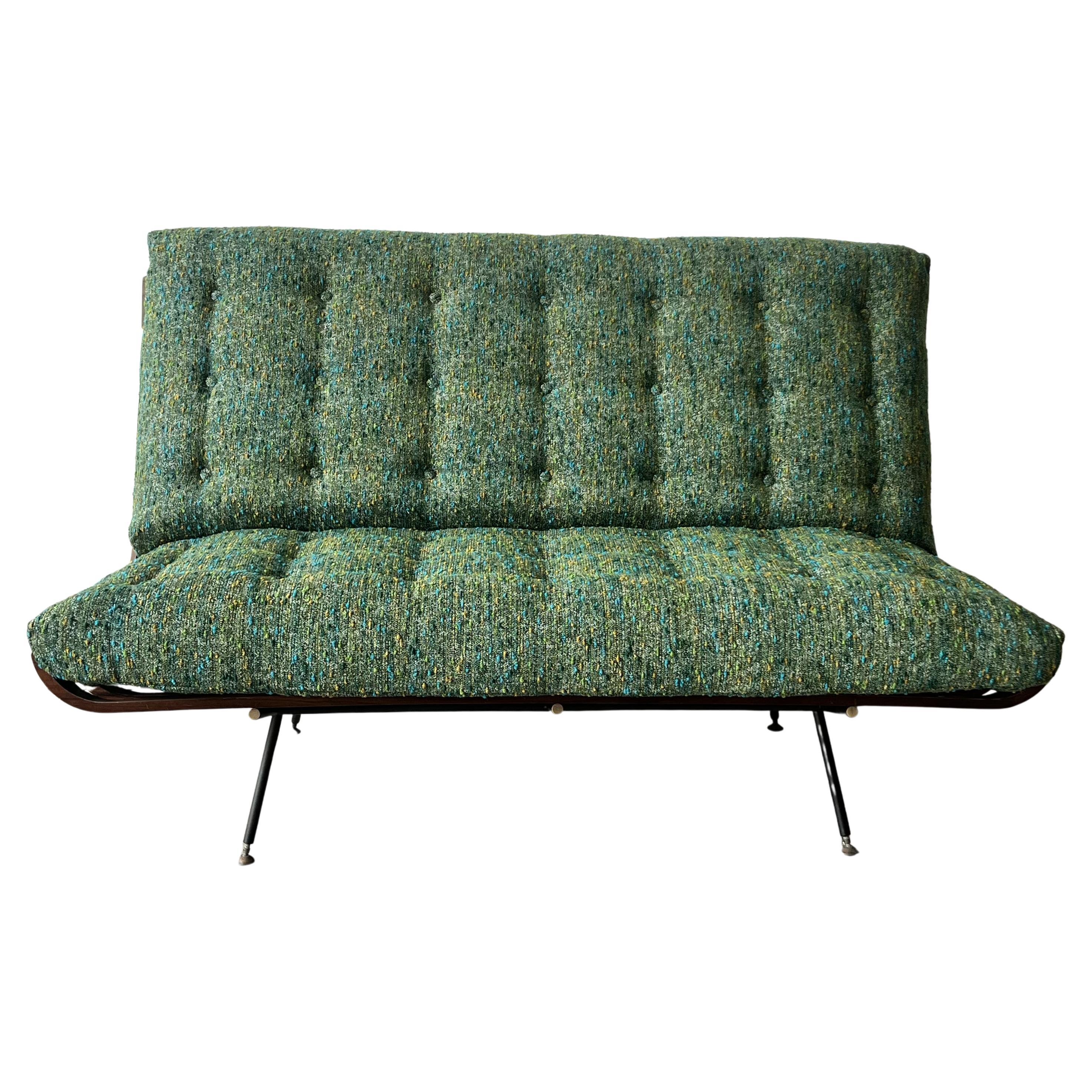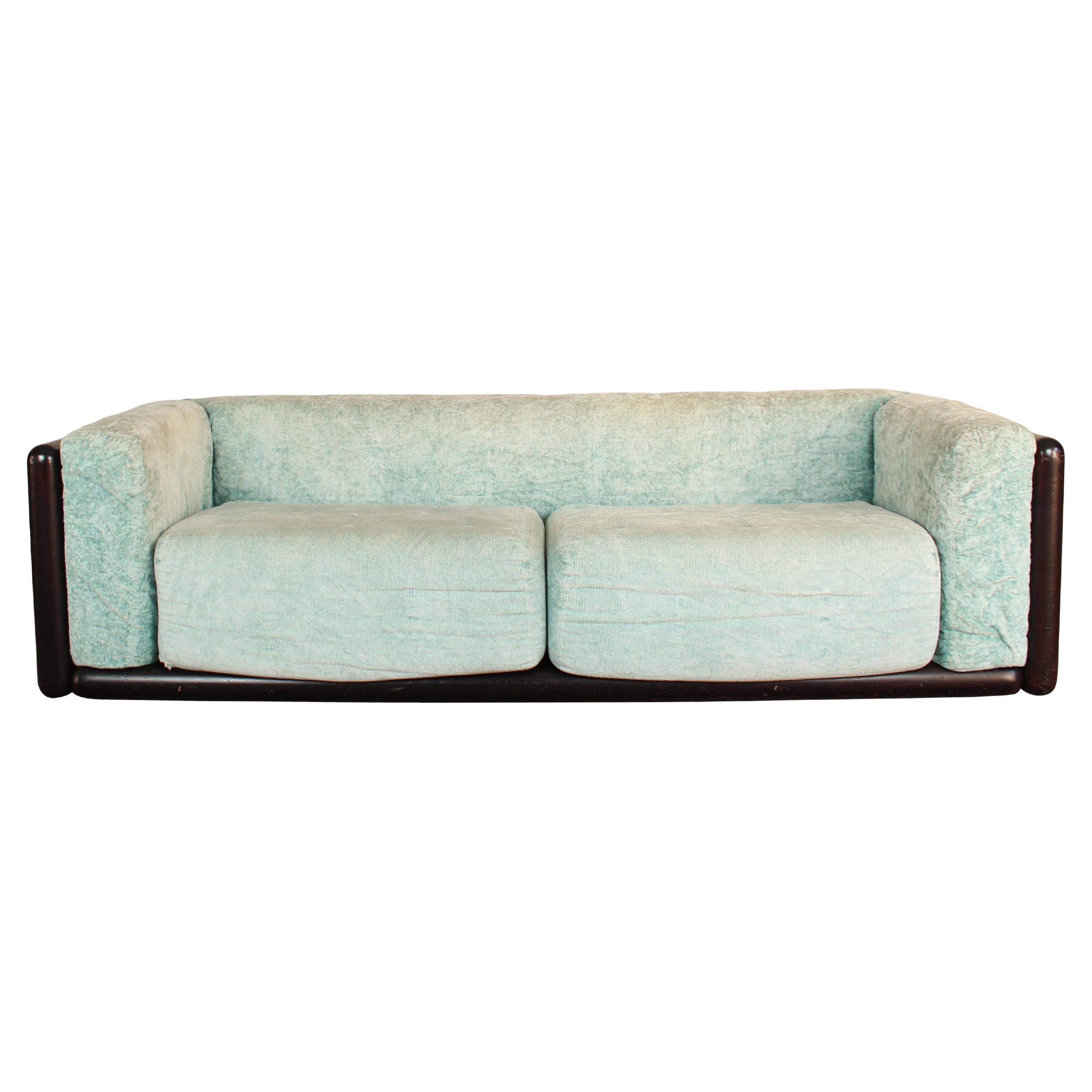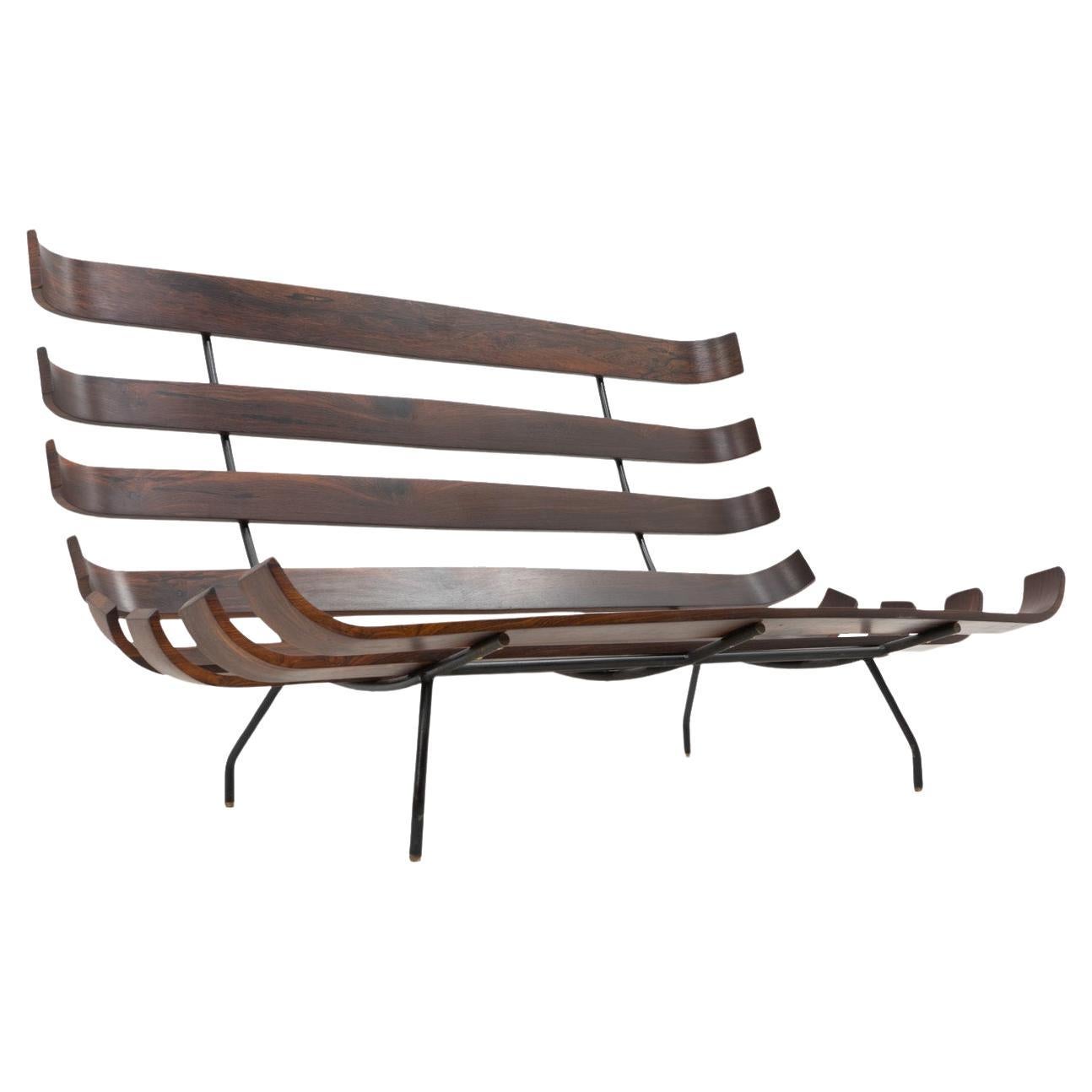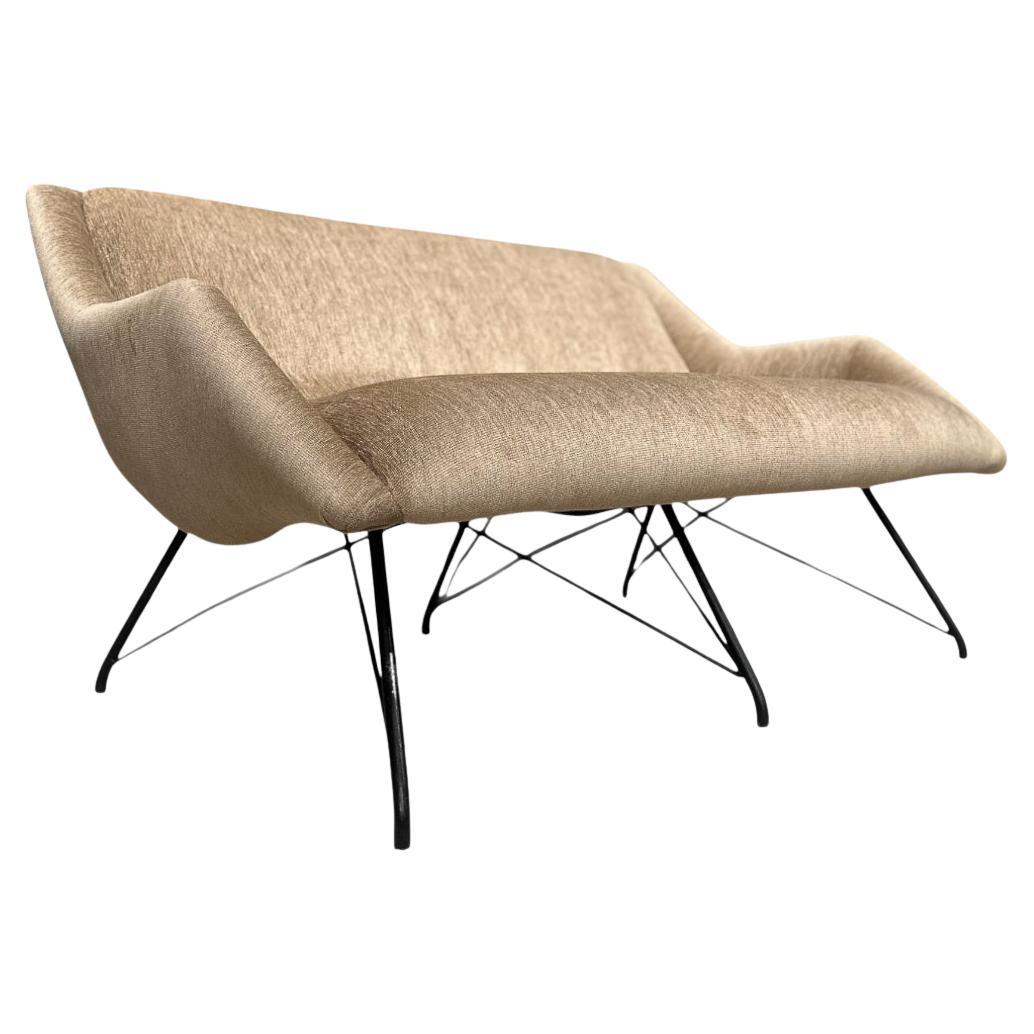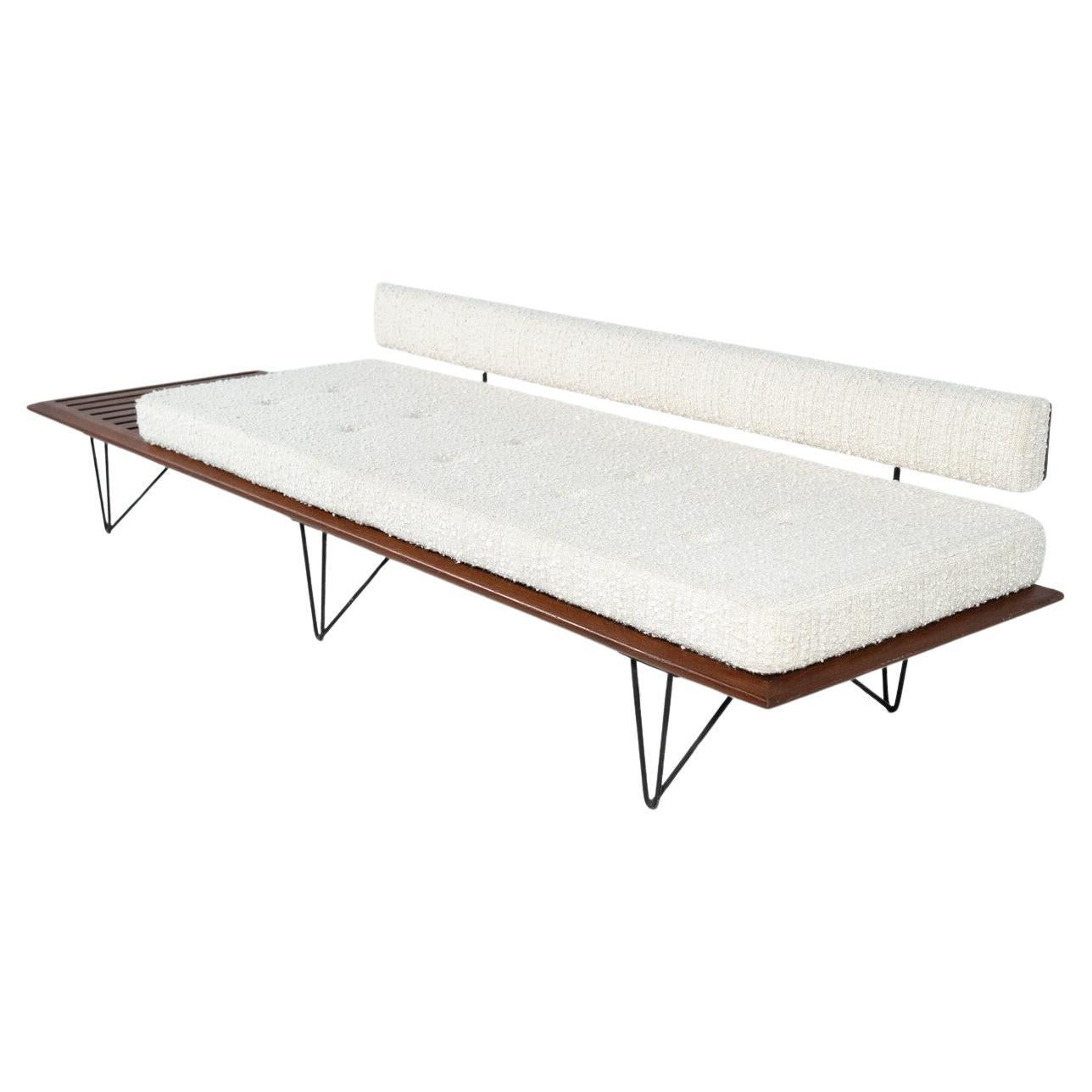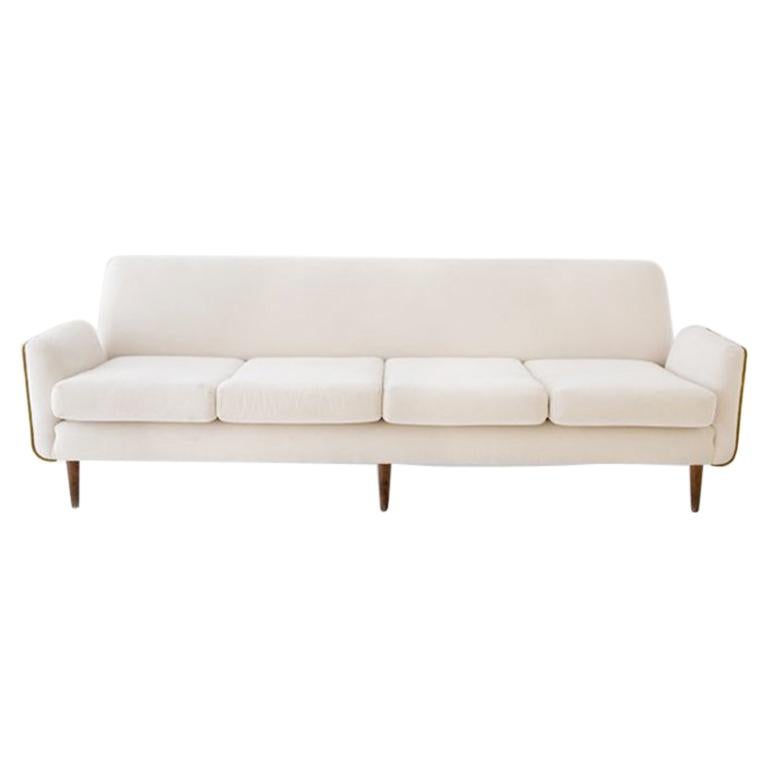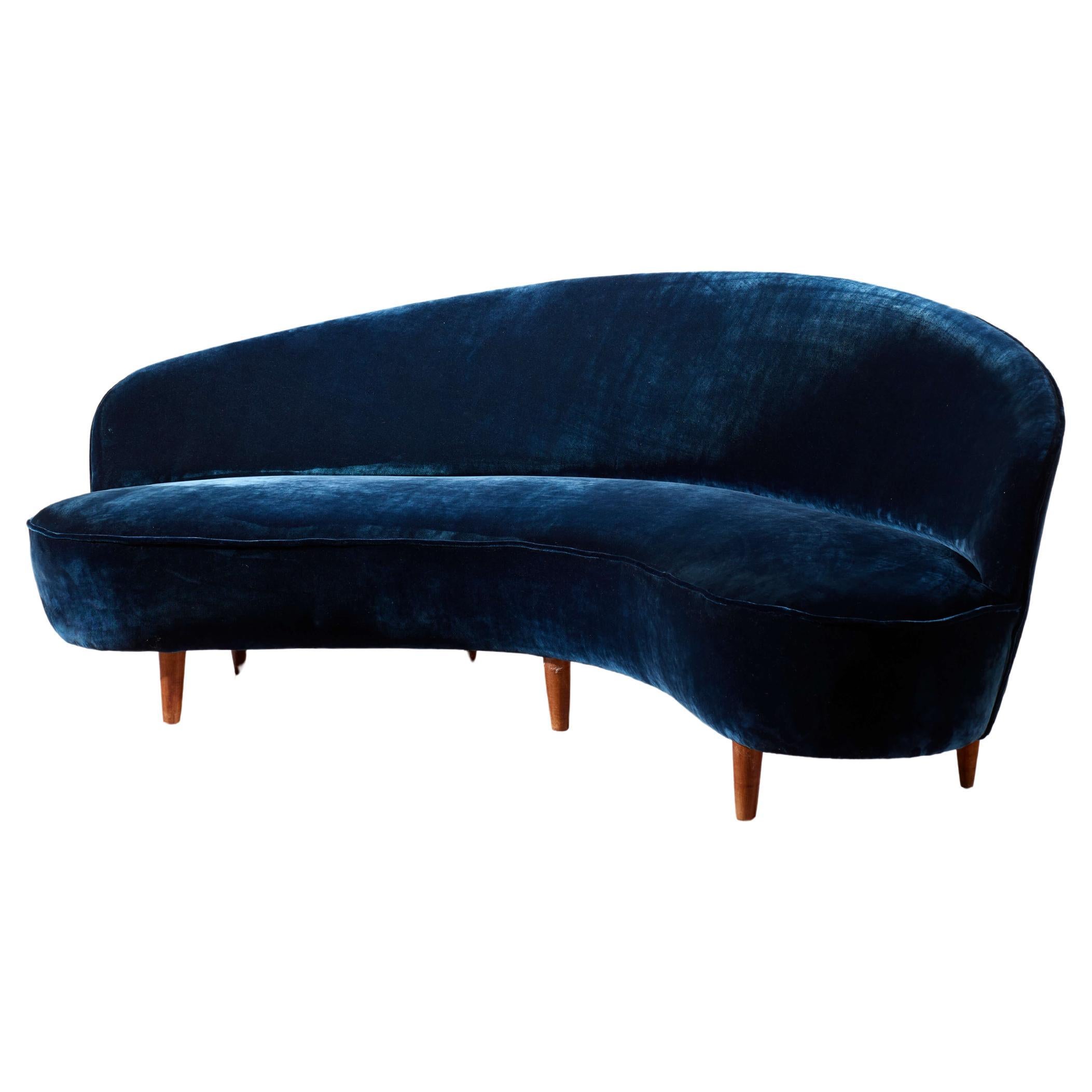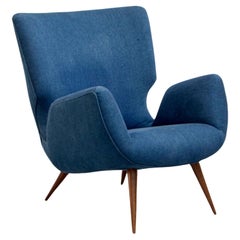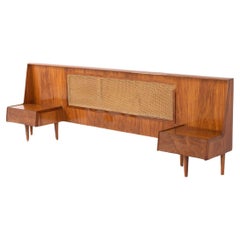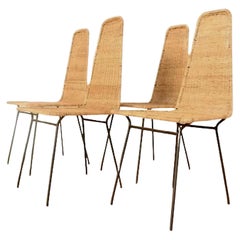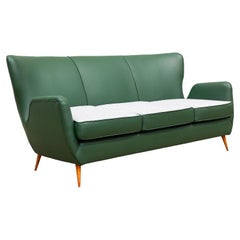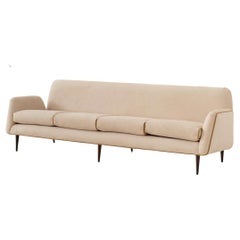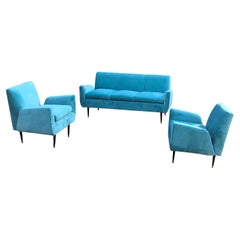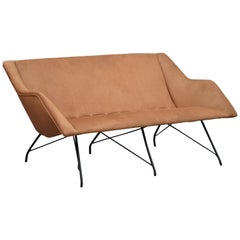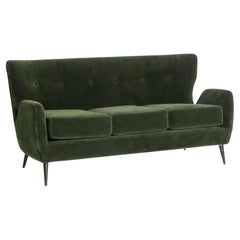
Carlo Hauner. Sofa, c. 1950. Green cotton velvet and wood
View Similar Items
Want more images or videos?
Request additional images or videos from the seller
1 of 8
Carlo Hauner. Sofa, c. 1950. Green cotton velvet and wood
About the Item
- Creator:Carlo Hauner (Designer)
- Dimensions:Height: 33.47 in (85 cm)Width: 66.93 in (170 cm)Depth: 30.32 in (77 cm)Seat Height: 18.51 in (47 cm)
- Style:Mid-Century Modern (Of the Period)
- Materials and Techniques:
- Place of Origin:
- Period:
- Date of Manufacture:c. 1950
- Condition:Refinished. Reupholstered. Wear consistent with age and use. Very Good, with new upholstery in green cotton velvet.
- Seller Location:PARIS, FR
- Reference Number:1stDibs: LU6408243073272
About the Seller
No Reviews Yet
Vetted Professional Seller
Every seller passes strict standards for authenticity and reliability
Established in 2021
1stDibs seller since 2022
15 sales on 1stDibs
Authenticity Guarantee
In the unlikely event there’s an issue with an item’s authenticity, contact us within 1 year for a full refund. DetailsMoney-Back Guarantee
If your item is not as described, is damaged in transit, or does not arrive, contact us within 7 days for a full refund. Details24-Hour Cancellation
You have a 24-hour grace period in which to reconsider your purchase, with no questions asked.Vetted Professional Sellers
Our world-class sellers must adhere to strict standards for service and quality, maintaining the integrity of our listings.Price-Match Guarantee
If you find that a seller listed the same item for a lower price elsewhere, we’ll match it.Trusted Global Delivery
Our best-in-class carrier network provides specialized shipping options worldwide, including custom delivery.More From This Seller
View AllCarlo Hauner, Armchair, 1950's, Caviuna Wood and Blue Cotton
By Carlo Hauner
Located in PARIS, FR
A typical piece of Carlo Hauner's design from the 1950s, this armchair rests on four conical legs, known in Brazilian as "Pè palito". The wide, curved backrest gives it depth while t...
Category
Mid-20th Century Brazilian Mid-Century Modern Armchairs
Materials
Textile, Wood
Carlo Hauner. Magazine holder, c. 1950
By Carlo Hauner
Located in PARIS, FR
This rare magazine rack, designed around 1950 by Carlo Hauner, subtly combines elegance and functionality. Based on a black lacquered metal base, it exudes a contemporary look while ...
Category
Mid-20th Century Brazilian Mid-Century Modern Magazine Racks and Stands
Materials
Metal, Copper
Carlo Hauner Headboard, c. 1950 Forma Edition
By Forma, Carlo Hauner
Located in PARIS, FR
Made of Caviuna wood, with a matching veneer and a delicate cane, this piece combines the robustness of the wood with the delicacy of the cane. The generous dimensions of 82 x 257 x ...
Category
Mid-20th Century Brazilian Mid-Century Modern Daybeds
Materials
Straw, Laminate, Hardwood
Carlo Hauner. Suite of 4 Rattan chairs, c. 1950. Metal and rattan
By Carlo Hauner
Located in PARIS, FR
The suite of 4 rattan chairs designed by Carlo Hauner, dating from about 1950, is a superb example of timeless design. Made from rattan and metal, these chairs combine elegance and durability. Each chair is 95 centimeters high, 42 centimeters wide and 45 centimeters deep, with a seat height of 43 centimeters.
Rattan gives these chairs a natural and warm look, making them perfect for both indoor and outdoor use. The soft curves and clean lines of the design highlight Carlo Hauner's know-how and add a touch of elegance to any room.
These rattan chairs are not only aesthetically pleasing, but they also offer great comfort thanks to their ergonomic seat. The mixture of rattan and metal creates a harmonious balance between tradition and modernity, making these chairs an exceptional addition to any living space or dining room. The attention to detail and the quality of the manufacture make this suite of chairs...
Category
Mid-20th Century Brazilian Mid-Century Modern Chairs
Materials
Metal
Carlo Hauner. Pair of "Concha" armchairs, c. 1950. Metal and fabric
By Forma, Carlo Hauner
Located in PARIS, FR
Carlo Hauner (1927-1996)
Pair of "Concha" Armchairs, c. 1950
Metal and fabric
Dimensions: 78 x 62 x 78 cm (30 71/100 x 24 41/100 x 30 71/100 in)
This pair of iconic "Concha" ...
Category
Mid-20th Century Brazilian Mid-Century Modern Armchairs
Materials
Metal
Giuseppe Scapinelli. Sofa in Caviuna's wood, 4 seats, c. 1950
By Giuseppe Scapinelli
Located in PARIS, FR
Four-seater sofa in solid Caviuna wood, recently redone tapestry in unbleached linen. The finesse and sinuousness of the wooden round section legs and armrests marks the elegance of ...
Category
Mid-20th Century Brazilian Mid-Century Modern Sofas
Materials
Upholstery, Hardwood
You May Also Like
Brazilian Mid-Century Sofa in Hardwood, Leather and Fabric by Carlo Hauner 1950s
By Carlo Hauner
Located in New York, NY
Available today, with domestic shipping in the NYC metro area included, this Sofa in Hardwood, Leather and Fabric by Carlo Hauner, c. 1950s, is nothing less than gorgeous! Crafted f...
Category
Mid-20th Century Mid-Century Modern Sofas
Materials
Leather, Fabric, Hardwood
$14,000 Sale Price
20% Off
Forma S.a Rare Sofa by Carlo Hauner and Martin Eisler, Ca 1954 Midcentury Brazil
By Carlo Hauner, Carlo Hauner and Martin Eisler, Martin Eisler
Located in New York, NY
This rare sofa was designed in 1955 and produced by Forma, a company directed by Carlo Hauner (1927- 1996) and Martin Eisler (1913- 1977). This piece is an icon and illustrates some ...
Category
Vintage 1950s Brazilian Mid-Century Modern Sofas
Materials
Leather, Rosewood
Martin Eisler & Carlo Hauner Modern Sofa & Armchairs Lounge Set, 1950s
By Carlo Hauner and Martin Eisler, Forma
Located in Whitstable, GB
Carlo Hauner & Martin Eisler midcentury sofa and armchairs; 1950s
Sofa designed for their manufacturing company, Forma around 1955.
This model is an icon of Brazilian midcentury design and was used to illustrate some advertisements for Forma in the 1950s.
We offer the set of sofa and matching armchairs. They are stunning together.
The set has been newly reupholstered in beautiful blue velvet, feet in imbuia wood, lacquered finish.
Sofa Dimensions: H28.35, W76.78, D30.32 in
H72, W195, D77 cm
Armchairs Dimenions: H 28.35, W30.32, D30.32 in
H72, W77, D77 cm
The creative duo were the leading designers behind the Brazilian furniture company Forma, and produced many celebrated pieces of Brazilian midcentury design.
Martin Eisler (1913-1977) was born in Vienna, and studied architecture in his country.
Eisler left Europe in 1938 due to the rise of fascist regimes. He first lived in Buenos Aires, where he settled and worked as an architect and designer. There here...
Category
Mid-20th Century Brazilian Mid-Century Modern Sofas
Materials
Velvet, Hardwood
$24,361 Sale Price / set
35% Off
"Concha" Sofa by Carlo Hauner and Martin Eisler, Modern Brazilian Design, 1950s
By Carlo Hauner and Martin Eisler
Located in New York, NY
Designed by Carlo Hauner and Martin Eisler, modern Brazilian sofa, iron, and velvet. Brazil, circa 1950s.
Shell or "Concha" sofa is made of iron and recently reupholstered in yellow velvet by the experienced craftsmen in our team. The upholstery was chosen considering the contemporary proposal of the piece.
The sofa features a comfortable seat, clean design, and freedom of user movements and is constructed in a frame with metal rods elegantly positioned to give strength to the piece, a common trait of designers.
The buttons velvet coated between seat and backs were used, by the designers, for an excellent velvet finish, and the restoration proposal was to maintain them.
Martin Eisler and Carlo Hauner were the primary designers for the iconic Brazilian furniture...
Category
Vintage 1950s Brazilian Mid-Century Modern Sofas
Materials
Iron
Costela Sofa by Martin Eisler and Carlo Hauner
By Carlo Hauner and Martin Eisler
Located in Red Lion, PA
Costela Sofa made out of wood with metal legs
Comes with reupholstered cushions
Very good condition
Carlo Hauner and Martin Eisler for Forma
Brazil 1950s,
Category
Mid-20th Century Sofas
Materials
Metal
Carlo Scarpa Iroko Wood and Green Velvet Cornaro Sofa for Studio Simon, 1974
By Studio Simon, Carlo Scarpa
Located in Vicenza, IT
Cornaro two-seater sofa, designed by Carlo Scarpa and manufactured by Studio Simon in 1974.
Made of Iroko wood, foam, and azure chenille velvet.
Excellent vintage condition.
Born in Venice on June 2nd, 1906, Carlo Scarpa began working very early. Only a year after he had first qualified as an architect in 1926, he began working for the Murano glassmakers Cappellin & Co. in a consultative capacity; from 1927, he began to experiment with the Murano glass, and this research not only gave him excellent results here but would also inform his progress for many years to come. Between 1935 and 1937, as he entered his thirties, Carlo Scarpa accepted his first important commission, the renovation of Venice’s Cà Foscari. He adapted the spaces of this stately University building which stands on the banks of the Grand Canal, creating rooms for the Dean’s offices and a new hall for academic ceremonies; Mario Sironi and Mario De Luigi were charged with doing the restoration work on the frescos. After 1945, Carlo Scarpa was constantly busy with new commissions, including various furnishings and designs for the renovation of Venice’s Hotel Bauer and designing a tall building in Padua and a residential area in Feltre, all worth mentioning. One of his key works, despite its relatively modest diminished proportions, was the first of many works which were to follow in the nineteen fifties: the [bookshop known as the] Padiglione del Libro, which stands in Venice’s Giardini di Castello and shows clearly Scarpa’s passion for the works of Frank Lloyd Wright. In the years which were to follow, after he had met the American architect, Scarpa repeated similar experiments on other occasions, as can be seen, in particular, in the sketches he drew up in 1953 for villa Zoppas in Conegliano, which show some of his most promising work. However, this work unfortunately never came to fruition. Carlo Scarpa later created three museum layouts to prove pivotal in how twentieth-century museums were set up from then on. Between 1955 and 1957, he completed extension work on Treviso’s Gipsoteca Canoviana [the museum that houses Canova’s sculptures] in Possagno, taking a similar experimental approach to the one he used for the Venezuelan Pavilion at [Venice’s] Giardini di Castello which he was building at the same time (1954-56). In Possagno Carlo Scarpa was to create one of his most incredible ever works, which inevitably bears comparison with two other museum layouts that he was working on over the same period, those of the Galleria Nazionale di Sicilia, housed in the Palazzo Abatellis in Palermo (1953-55) and at the Castelvecchio in Verona (1957- 1974), all of which were highly acclaimed, adding to his growing fame. Two other buildings, which are beautifully arranged in spatial terms, can be added to this long list of key works that were started and, in some cases, even completed during the nineteen fifties. After winning the Olivetti Award for architecture in 1956, Scarpa began work in Venice’s Piazza San Marco on an area destined to house products made by the Industrial manufacturers Ivrea. Over the same period (1959-1963), he also worked on renovating and restoring the gardens and ground floor of the Fondazione Querini Stampalia in Venice, which many consider one of his greatest works. While he worked on-site at the Fondazione Querini Stampalia, Carlo Scarpa also began building a villa in Udine for the Veritti family. To shed some light on how much his work evolved over the years, it may be useful to compare this work with that of his very last building, villa Ottolenghi Bardolino, which was near completion at the time of his sudden death in 1978. Upon completion of villa Veritti over the next ten years, without ever letting up on his work on renovation and layouts, Scarpa accepted some highly challenging commissions which were to make the most of his formal skills, working on the Carlo Felice Theatre in Genoa as well as another theatre in Vicenza.
Towards the end of this decade, in 1969, Rina Brion commissioned Carlo Scarpa to build the Brion Mausoleum in San Vito d’Altivole (Treviso), a piece he continued to work on right up until the moment of his death. Nevertheless, even though he was totally absorbed by work on this mausoleum, plenty of other episodes can offer some insight into the final years of his career. As work on the San Vito d’Altivole Mausoleum began to lessen in 1973, Carlo Scarpa started building the new headquarters for the Banca Popolare di Verona. He drew up plans that were surprisingly different from the work he carried out simultaneously on the villa Ottolenghi. However, the plans Carlo Scarpa drew up, at different times, for a monument in Brescia’s Piazza della Loggia commemorating victims of the terrorist attack on May 28th, 1974, make a sharp contrast to the work he carried out in Verona, almost as if there is a certain hesitation after so many mannered excesses. The same Pietas that informs his designs for the Piazza Della Loggia can also be seen in the presence of the water that flows through the Brion Mausoleum, almost as if to give a concrete manifestation of pity in this twentieth-century work of art. Carlo Scarpa has put together a highly sophisticated collection of structures occupying the mausoleum’s L-shaped space stretching across both sides of the old San Vito d’Altivole cemetery. A myriad of different forms and an equally large number of different pieces, all of which are separate and yet inextricably linked to form a chain that seems to offer no promise of continuity, arising out of these are those whose only justification for being there is to bear the warning “si vis vitam, para mortem,” [if you wish to experience life prepare for death] as if to tell a tale that suggests the circle of time, joining together the commemoration of the dead with a celebration of life. At the entrance of the Brion Mausoleum stand the “propylaea,” followed by a cloister that ends by a small chapel, with an arcosolium bearing the family sarcophagi, the central pavilion, held in place on broken cast iron supports, stands over a mirror-shaped stretch of water and occupies one end of the family’s burial space. The musical sound of the walkways, teamed with the luminosity of these harmoniously blended spaces, shows how, in keeping with his strong sense of vision, Carlo Scarpa could make the most of all his many skills to come up with this truly magnificent space. As well as an outstanding commitment to architectural work, with the many projects we have already seen punctuating his career, Carlo Scarpa also made many equally important forays into the world of applied arts. Between 1926 and 1931, he worked for the Murano glassmakers Cappellin, later taking what he had learned with him when he went to work for the glassmakers Venini from 1933 until the 1950s. The story of how he came to work on furniture design is different, however, and began with the furniture he designed to replace lost furnishings during his renovation of Cà Foscari. The later mass-produced furniture started differently, given that many pieces were originally one-off designs “made to measure.” Industrial manufacturing using these designs as prototypes came into being thanks to the continuity afforded him by Dino Gavina, who, as well as this, also invited Carlo Scarpa to become president of the company Gavina SpA, later to become SIMON, a company Gavina founded eight years on, in partnership with Maria Simoncini (whose own name accounts for the choice of company name). Carlo Scarpa and Gavina forged a strong bond in 1968 as they began to put various models of his into production for Simon, such as the “Doge” table, which also formed the basis for the “Sarpi” and “Florian” tables. In the early seventies, other tables that followed included “Valmarana,” “Quatour,” and “Orseolo.” While in 1974, they added a couch and armchair, “Cornaro,” to the collection and the “Toledo” bed...
Category
Vintage 1970s Italian Mid-Century Modern Living Room Sets
Materials
Velvet, Foam, Chenille, Wood
Recently Viewed
View AllMore Ways To Browse
Niels Moller Round Extendable Dining Table
Niermann Weeks Console
Nigerian Carved Wood Table
Nikari April Table
Niki Smith
Nina Edwards Sofa
Nino Caffe
Nio Guardians
Nipper The Dog
Noritake Coffee Set
Noritake Teapot
North Carolina Flags
Noura Bed
Novo Rumo Dining Table
Nurit Amdur
Nurses Silver Buckle
Nyhavn Desk
Nymphenburg Porcelain Service
